Double your marketing campaign’s performance overnight with this one easy trick.
If that sounds like one of those weight loss ads you’ve seen a thousand times, well, that’s because it is.
Sort of.
Unlike those “one weird trick” ads, there’s actually some truth to my outrageous marketing claim.
It won’t happen overnight, and it isn’t snap-your-fingers easy, but there is a tried-and-true way to potentially double your marketing campaign’s performance with the audience you currently have.
Marketing segmentation.
What’s in This Guide?
Are you one of the 89% of marketers leaving conversions on the table?
If so, this guide has you covered. And, true to its subject matter, it’s broken into seven segments:
- What is marketing segmentation?
- Why does segmentation work?
- The four Cs of marketing (not the four Ps)
- Which channels can be segmented?
- Five ways to segment your target audience
- How to incorporate marketing segmentation into your business today
- How to monitor campaign performance using tools like TrueNorth to optimise returns
Let’s start at the top.
What Is Marketing Segmentation?
Marketing segmentation is the practice of dividing your target audience into smaller groups with similar needs, interests, or other characteristics who are likely to respond positively to targeted marketing campaigns.
Segmenting your marketing campaigns requires more work — understanding your audience, creating multiple campaigns, and optimising those campaigns — but it’s proven to drive massive returns.
Just take a look at these statistics on the benefits of segmented email marketing campaigns:
- 14.3% increase in email open rates
- 101% increase in click-through rates
- 760% increase in email-driven revenue
Sources: HubSpot and Campaign Monitor
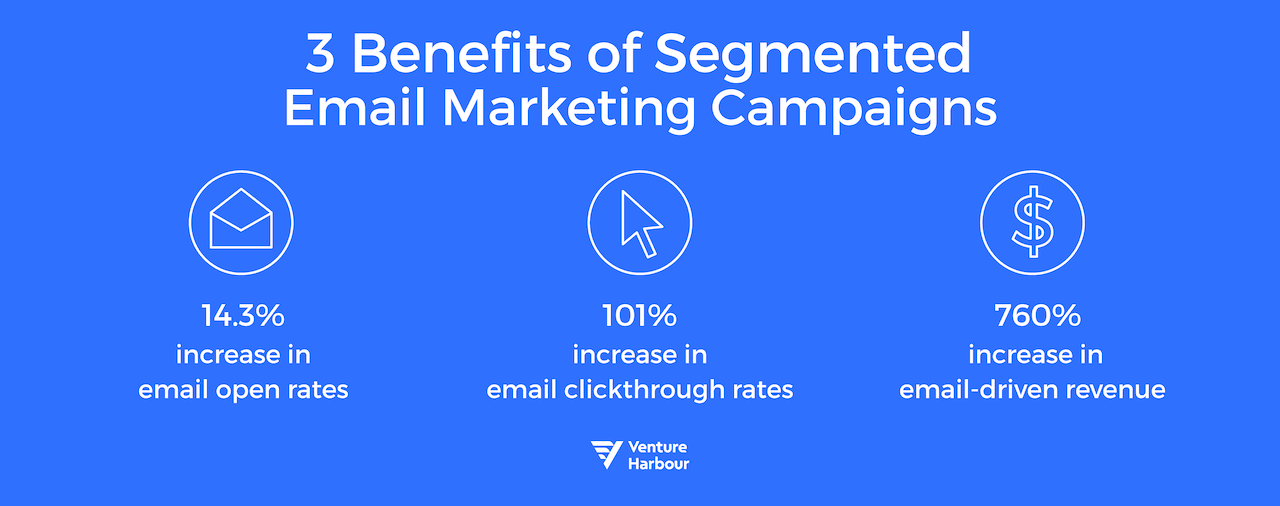
Why Does Marketing Segmentation Work?
Marketing segmentation works because it puts the right message in front of the right person at the right time.
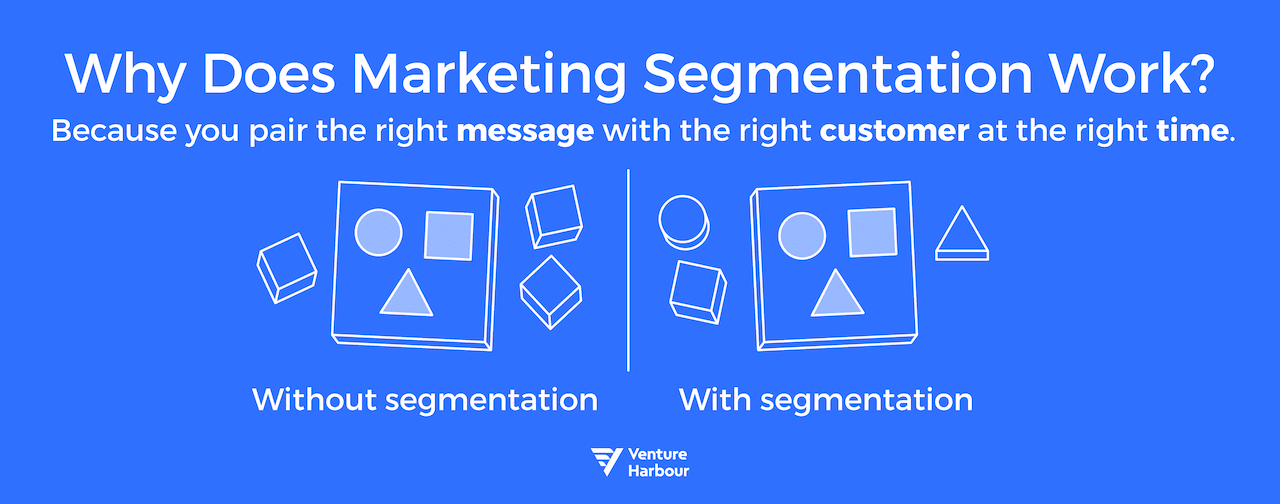
Let’s say you’re in charge of marketing for a pet food brand, and your company sells the highest-quality, all-natural dog and cat food. Your company just released its newest formulations for both dogs and cats made with real Alaskan salmon, each of which sells for $50.
You have an email list of 10,000 enthusiastic pet owners split into two equal-sized groups:
- 5,000 who only have dogs
- 5,000 who only have cats
(For the sake of simplicity, we’ll pretend no one on the list has both a dog and a cat.)
What’s the best way to promote your company’s newest product to your email list subscribers?
Let’s look at two different email marketing campaigns.
Campaign 1: Unsegmented
The easiest option is to send one email to all 10,000 subscribers unveiling your new products for both dogs and cats.
You use a generic subject line — “Hey, [name]…does your pet like REAL Alaskan salmon?” — and pitch both the new dog and cat food in the body of your email.
The results?
- 17.5% open rate (1,750 opens)
- 22.9% click-to-open rate (400 clicks to product page) for a 4% clickthrough rate
- 2.25% conversion rate on your product page (9 conversions)
- $50 average order value (each conversion buys one, either for dogs or cats)
- $450 revenue and $0.045 per subscriber
Campaign 2: Two segments
Another option is to segment your list based on what you know about your subscribers: the types of animals they have. You create two separate emails — one for dog owners and one for cat owners — and drive recipients to the appropriate landing page.
The first difference is the subject line. This time you can get more targeted:
- “Hey, [name]…does your DOG like REAL Alaskan salmon?”
- “Hey, [name]…does your CAT like REAL Alaskan salmon?”
Those targeted subject lines result in higher open rates.
Each email body is more targeted too. And because you aren’t wasting valuable email real estate pitching cat food to dog owners and vice versa, you’re able to write more compelling email copy that boosts your click-to-open rates.
Another benefit: Your targeted landing pages are more tailored to your subscribers, promoting only the relevant product.
The results?
- 20% open rate (2,000 opens)
- 40% click-to-open rate (800 clicks to product page) for an 8% clickthrough rate
- 2.5% conversion rate on your product page (20 conversions)
- $50 average order value (each conversion buys one, either for dogs or cats)
- $1,000 revenue and $0.10 per subscriber
Scenario 2’s segmented campaign generated $550 more revenue (+122.2%) despite marketing to the exact same list.
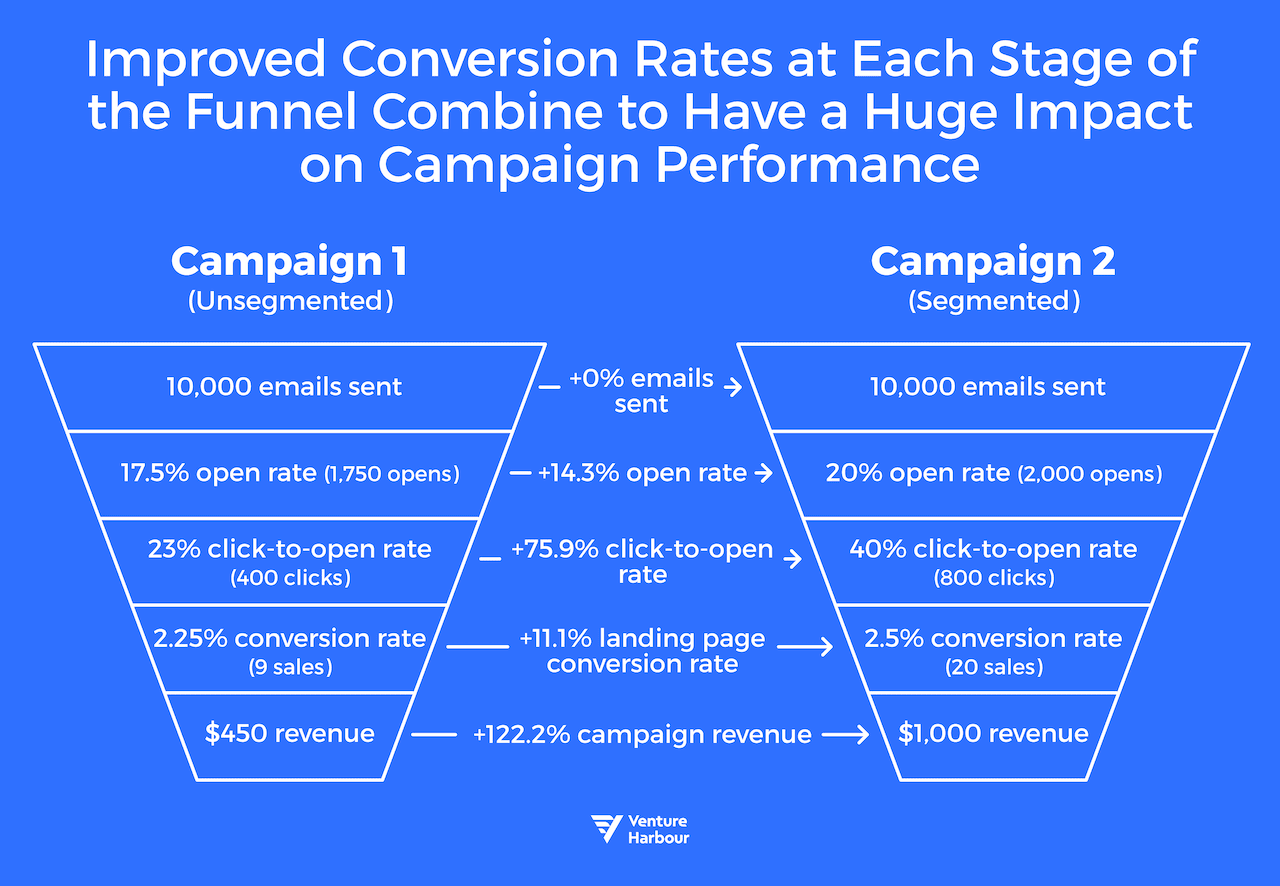
Why (exactly) did the segmented campaign outperform the unsegmented campaign?
The segmented campaign’s 122.2% increase in revenue was due to a series of incremental improvements to every stage of the email marketing funnel:
- Increased open rates due to more personalised email subject lines
- Increased click-to-open rates due to more targeted email copy
- Increased product page conversion rates due to more targeted product page copy
When linked together in your sales funnel, these increases multiply for massive incremental campaign returns.
Best of all, the numbers used in the example above are in line with the statistics about the benefits of segmented email campaigns mentioned at the beginning of this guide.
Let’s compare the performance Campaign 1 and Campaign 2’s:
| Email Funnel Step | Campaign 1 (Unsegmented) | Campaign 2 (Segmented) | Change | Compare Improvement To |
| Delivered Emails | 10,000 | 10,000 | 0 (0%) | – |
| Opened Emails | 1,750 | 2,000 | +250 (100%) | 14.3% (HubSpot) |
| Clicks to Product Page | 400 | 800 | +400 (100%) | 101% (HubSpot) |
| Product Page Conversion Rate | 2.25% | 2.5% | +0.25 (11.1%) | Assumption* |
| Conversions | 9 | 20 | +11 (122.2%) | – |
| Revenue Per Conversion | $50 | $50 | $0 (0%) | – |
| Total Revenue | $450 | $1,000 | +$550 (122.2%) | – |
| Revenue per Subscriber | $0.045 | $0.10 | +$0.055 (122.2%) | – |
*Targeted email campaigns let you create targeted landing pages, which increases conversion rates.
If you could get a 100% increase on your email campaign’s click-through rate and a 111.1% increase in both conversions and revenue just by creating an extra email and landing page targeted to your recipients, wouldn’t you?
The 4 Cs of Marketing (not the 4 Ps)
Intuitively, this all makes sense. Put the right message in front of the right person, and you’ll increase the likelihood of that person completing your desired action.
But that begs a new question: What is the right message, and how do you create it?
Traditionally, your marketing campaign’s message began with your marketing mix, also known as the four Ps:
- Product: Understanding the features, usability, value, and life cycle of your product.
- Price: The amount you charge and how that price relates to both the real and perceived value of your product.
- Place: Where to sell your product.
- Promotion: How to sell your product and communicate its value to your target customers.
Do you see the problem with this approach? None of those Ps talk about the customer.
Today, most marketers have replaced the four Ps with the four Cs:
- Customer Wants & Needs: The problem your product solves for the customer. Use empathy and help them realise why they need your solution.
- Cost: The amount your customer pays for your product and how they perceive that price. This also includes the opportunity cost to your customer of choosing to spend their finite resources on your product over either competitor products or other initiatives unrelated to your product.
- Convenience: How easy it is for customers to find your product and purchase it. This includes how seamless your sales funnel is and your order fulfilment and shipping time.
- Communication: The conversation you have with your customers to communicate how your product solves their problem and make them feel confident in both your brand and their purchase.
The four Cs cover the same factors as the four Ps, but they do it from the customer’s perspective instead of the business’s.
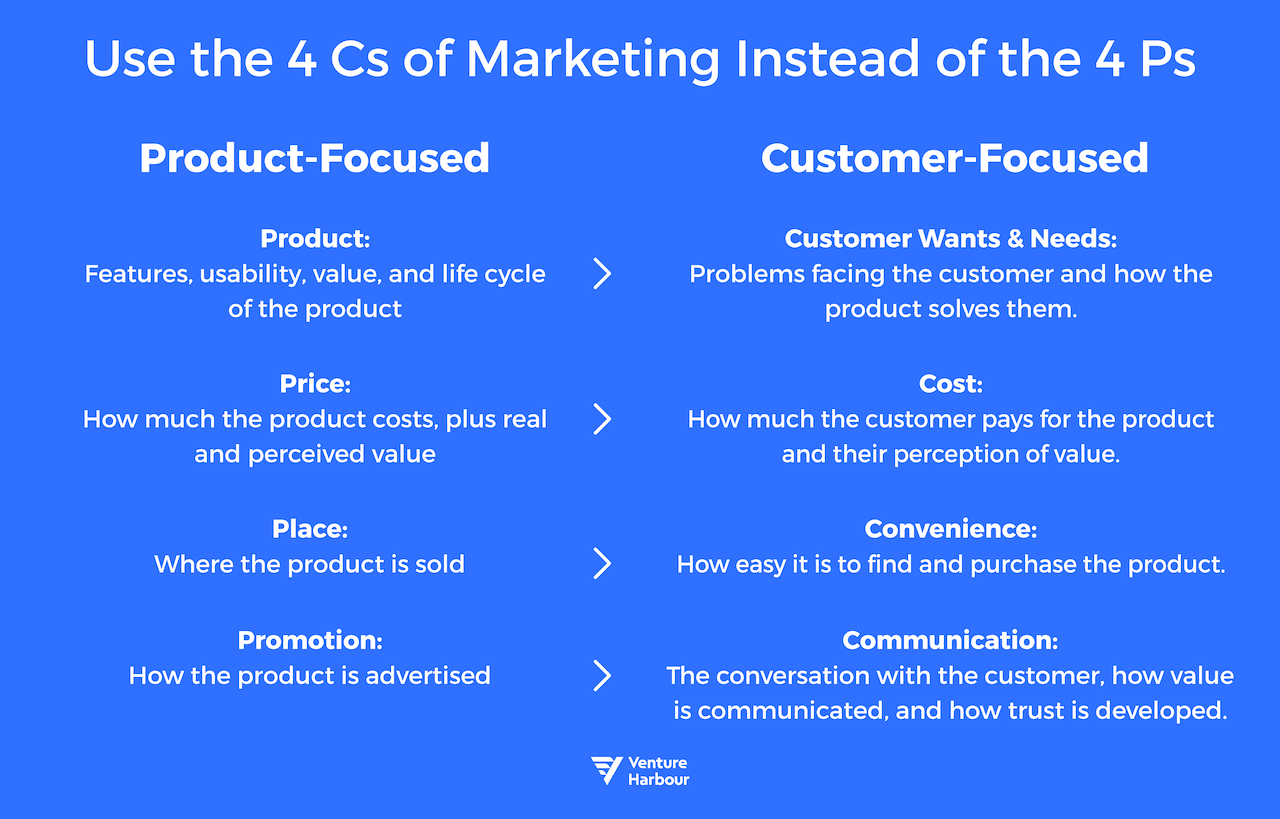
Why does this subtle shift in thought process matter? Think of it this way: When you’re at a holiday party meeting new people, which of these two people are you more likely to remember favourably:
- Mark, who asks about your hobbies and genuinely tries to get to know you.
- Dave, who talks the entire time about why mountain climbing is “just so rad.”
Don’t be Dave. Communicate with your audience. Don’t talk at them.
Which Marketing Channels Can Be Segmented?
Segmentation most often is associated with email marketing, but you can segment virtually every marketing channel for optimised results:
- Email: When you build your email list, think about what you know about your subscribers. Which of your products are they interested in? Where are they in your sales funnel? Have they purchased from you before? Your initial email to someone who hasn’t purchased yet will be different than your upsell or support email to someone who has.
- Social Media: Each platform has different user demographics, which means the makeup of your audience is different. What messages are you communicating to followers on each platform? Is it targeted to that platform or generic across all social media platforms?
- PPC: Think about the keywords you’re targeting. What’s the intent for people searching with those keywords? Does your ad speak to those users? Are you directing them to a relevant landing page?
- Content Marketing: When you create and publish content, what topics and keywords are you targeting with that content? When people consume it, where are they in your marketing funnel? Are you putting the right CTA in front of them?
- Podcasts: Podcast advertising offers access to a growing, niched-down audience that’s highly-responsive to carefully-segmented marketing campaigns with 67% of podcast listeners reporting they remember brands and products from podcast ads. Consider the podcast you’re advertising on. What’s the style, theme, and tone of that show? How can you seamlessly integrate your brand’s message so it seems like native advertising?
- Traditional Offline Marketing: If you’re purchasing a billboard or newspaper ad, where will people see your campaigns? What do those people care about?
That isn’t an exhaustive list of marketing channels, but the point is clear: No matter which channels your brand uses, think about the audience you’re speaking to and tailor your message to them.
Well, hold up. How do you evaluate and segment your audience?
5 Ways to Segment Your Audience
There are five ways to segment your audience, regardless of whether you’re a B2C or B2B company:
- Demographic
- Geographic
- Psychographic
- Behavioural
- Contextual
Let’s take a look at each.
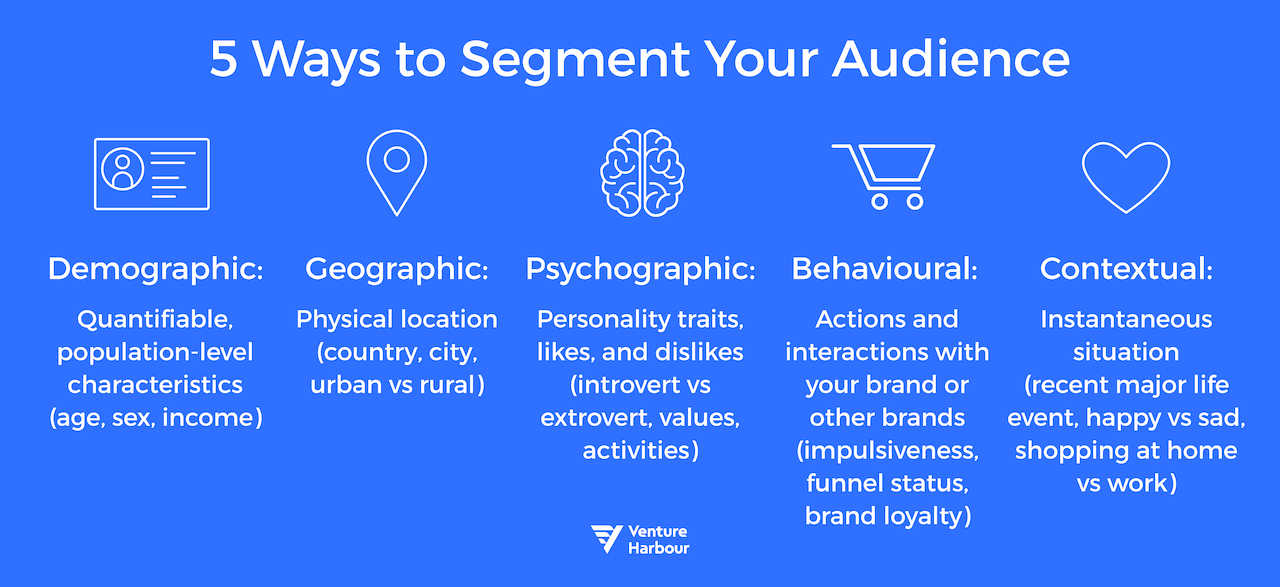
1. Demographic
Demographic segmentation focuses on quantifiable, population-level characteristics. Most people are familiar with segments in the context of B2C companies:
- Age
- Sex and gender
- Race and ethnicity
- Income
- Education
- Relationship status
- Family environment
- Homeownership status
For B2B companies, think about the quantifiable, industry-level characteristics of the companies you market to:
- Industry or vertical
- Number of employees
- Annual revenue
Many of these characteristics, both for B2C and B2B companies, are easy ways to include or exclude customers and narrow your campaign’s focus quickly.
2. Geographic
Geographic segmentation focuses on the physical location of your customers:
- Country
- Region
- State or province
- City
- Postal code
- Urban, suburban, or rural
- Climate
If you’re a brick-and-mortar business offering services in a specific city, it’s important to narrow your marketing efforts to people within your service area.
3. Psychographic
Psychographic segmentation focuses on the personality traits, preferences, motivations, and attitudes of your customers. Because they’re harder to see, they’re usually harder to measure.
Examples of psychographic segments include the following:
- Personality, such as being an introvert or extrovert
- Lifestyle, such as the importance of health and fitness
- Social status, such as the importance of glamour or having the “latest and greatest”
- Values, such as the importance of family
- Motivations, such as pride
- Priorities in life, such as advancing their career
- Activities and interests, such as cycling or cinema
- Political beliefs
- Fears, such as abandonment or financial struggle
Psychographic segmentation isn’t limited to B2C companies, though. Even if your business markets to other businesses, remember that those businesses are still made up of people. What do your contacts at those businesses care about?
Brands that have both psychographic information about their audience and well-developed psychographic profiles for their marketing personas can create highly-targeted and effective campaigns that resonate with customers.
4. Behavioural
Behavioural segmentation focuses on actions and interactions with your brand, other brands, and as a consumer in general:
- Impulsiveness
- User status, such as non-user, existing user, or former user
- Sales funnel status
- Previous interactions with your brand
- Previous interactions with other brands
- How they use your product
- Brand loyalty
5. Contextual
Every guide to marketing segmentation includes the first four — demographic, geographic, psychographic, and behavioural — but most forget this one because it isn’t a trait or characteristic of your target customer.
Contextual segmentation is more about your target customer’s instantaneous situation. Here are a few examples:
- Recent major life milestone, such as just married or laid off
- State of mind, such as happy or sad
- Transient physical location, such as at work or at home
- Shopping situation, such as at the store with a spouse or alone
It may feel like contextual segmentation overlaps the four common marketing segments above, but, in reality, it’s adding an extra level of detail or granularity that can take an already-targeted campaign and make it feel intimate.
Example: Going back to our all-natural pet food brand, let’s say you have a customer persona named Pete. Pete is a 30-something male and first-time pet owner who has a medium-sized dog. He has a full-time job and no significant other or kids, he owns his own home in the suburbs, and he enjoys running with his dog.
That’s a lot of valuable information about Pete to create a targeted marketing campaign. But what if you also knew Pete, a first-time pet owner, just adopted his dog last week?
Contextually, Pete is a novice pet owner even by first-time pet owner standards. Now you can create hyper-targeted campaigns pitching all sorts of dog food, training treats, and other products to catch Pete in his dog-ownership honeymoon phase.
How to Incorporate Marketing Segmentation for Your Business Today
Integrating segmentation into your brand’s marketing plan may seem daunting, but it’s less complicated than you think.
1. Research your market
The first step in segmenting your audience is to understand it.
If you’re an existing brand, you probably have a wealth of customer data available to you:
- Information about who’s purchased
- Website visitor demographic and geographic data from Google Analytics
- Content performance statistics from Google Analytics
- Historic email marketing campaign performance
- Historic PPC campaign performance
- Surveys, questionnaires, or other forms of customer feedback
- Social media audience insights
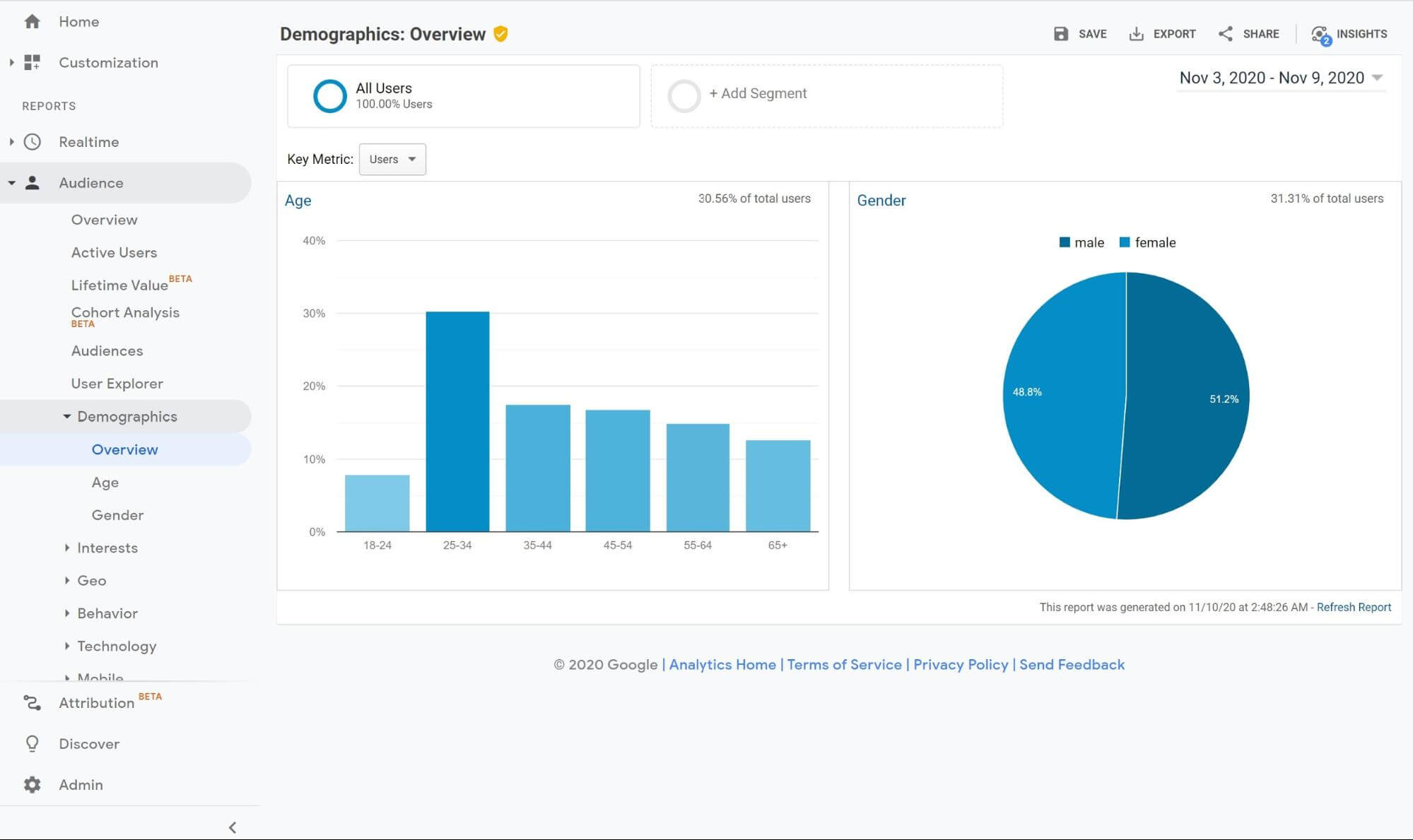
If you’re a new brand without an existing audience or following, there are a few ways you can estimate your market:
- Information about your competitors and their customers
- Your product, the problems it solves, and who cares about those problems
- Publicly-available data, such as industry research and reports and census data
- Focus groups, surveys, and user-testing
Perfect is the enemy of good, especially if you’re just getting started with marketing segmentation. If you only have basic demographic data available to you, start with that and work to improve your audience tracking and campaign performance over time.
2. Segment your audience by developing buyer personas
Buyer personas are detailed profiles of fictitious customers based on your market data. Each persona represents one group of customers who share common demographic, geographic, psychographic, behavioural, and contextual characteristics. It even helps to name your personas.
Developing and naming personas may seem like an unnecessary step; they’re invaluable when creating your specific campaigns.
If everyone on your team knows Pete, the male, 30-something, first-time dog owner with a full-time job, his own home, and a love of running, then it’s easy for everyone to envision how well Pete will respond to each email in your autoresponder sequence.
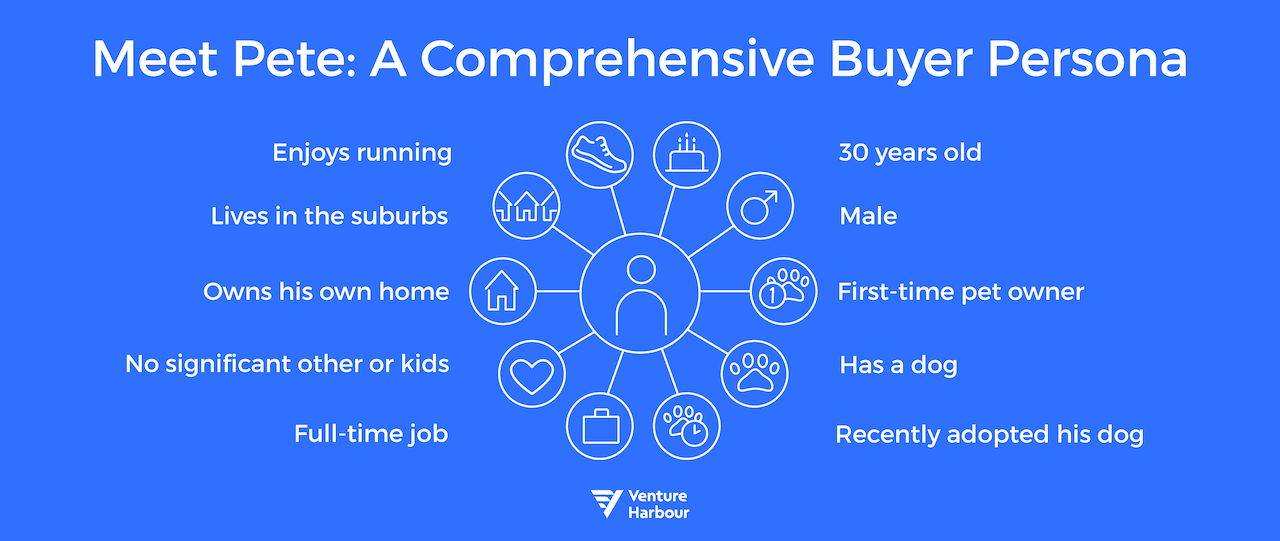
Just like everything else in marketing, your buyer personas should be under constant review and refinement. As you interact with Pete through subsequent campaigns and transactions, you’ll learn more about him, which allows you to add new psychographic or behavioural traits to shape how you communicate with him.
3. Create your campaigns
It’s time to begin creating your segmented marketing campaigns using your newly-developed buyer personas. This is where the 4 Cs come into play:
- Customer Wants & Needs: What does Pete want? What problems is Pete experiencing, and how does our product address those problems?
- Cost: How much value does Pete perceive our product to have, and how does that compare to our product’s price point?
- Convenience: How easy it is for Pete to find and purchase our product? Is it easy for him to complete the transaction? Are there any post-transaction gaps we need to address for a seamless user experience?
- Communication: How do we need to communicate with Pete? Where is he in our sales funnel? Have we communicated with him before? If so, how has he responded to our messages? How do we speak to Pete in a way he’ll be receptive to listening?
Now that you have a well-defined persona and a well-developed persona to communicate with that persona, it’s finally time for your campaign to go live.
4. Measure and optimise
But the work doesn’t end when your campaign begins. As potential customers begin to interact with your campaign, you can start collecting data on how they respond to it:
- What’s your email open rate?
- What’s your click-through rate?
- What’s your landing page’s conversion rate?
- How many Facebook shares do your posts get?
- What’s your cost per click for your PPC ad campaign?
- How many qualified leads are you generating?
- What’s your cost per lead?
And that’s just the tip of the iceberg.
There are 51 marketing metrics you should know as you track campaign performance. You don’t want to track every single one, but you do want to identify the core metrics that tell you whether your campaigns are meeting expectations. These are your True North metrics.
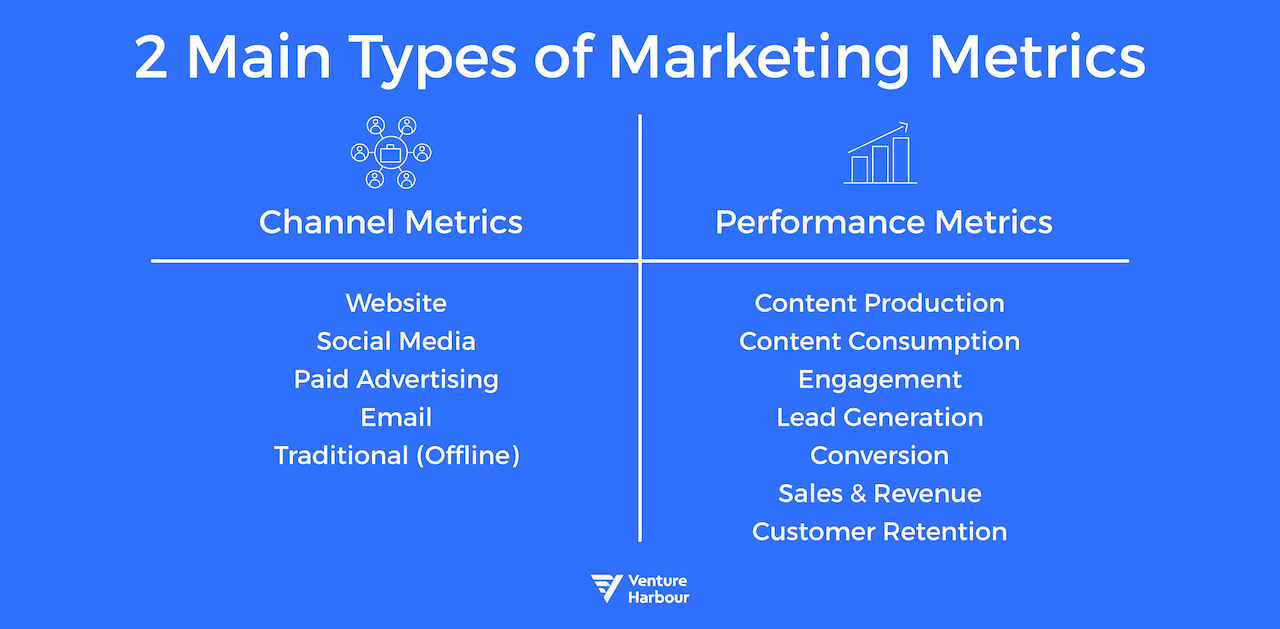
You also don’t want to wait months for your campaigns to run their course before assessing their performance. Short 1-3 week Agile marketing sprints can help you use early data to optimise your marketing efforts:
- Identify your high-performing marketing channels.
- Optimise your campaigns to those channels.
- Cut your low-performing channels and campaigns.
- Refine your buyer personas for better efficiency.
This real-time, read-and-react approach is crucial to maximise each campaign’s ROI and make the most of your company’s marketing budget.
Conclusion
If marketing segmentation doubles click-through rates and powers a 760% increase in email-driven revenue, then why do just 11% of marketers use it?
Complexity.
Your first segmented campaign doesn’t need 13 personas to be effective, but it does help to map out a few segments, measure their performance and optimise for better returns. While not rocket science, that’s more effort and moving parts than many marketers are used to.
And that’s where tools like TrueNorth shine.
TrueNorth is a marketing management system that helps marketing teams create adaptable plans, track campaign performance and prioritise high-performers. Its centralised reporting and ease of use are invaluable for brands trying to harness the power of segmentation.
If you’re interested in joining our beta, you can join here. As a Venture Harbour reader, you’ll be jumped to the front of the beta queue.




